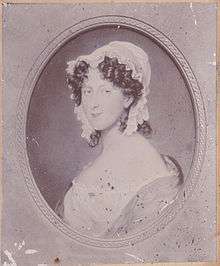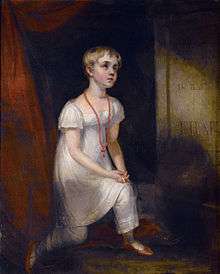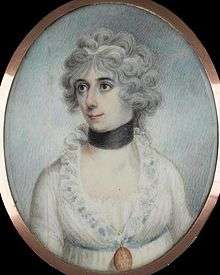Horatia Nelson

Horatia Nelson, christened as Horatia Nelson Thompson[1] (January 29, 1801 – March 6, 1881) was the illegitimate daughter of Emma Hamilton and Horatio Nelson.
Life
Early life
Born in a house of Sir William Hamilton (Emma's husband) at 23 Piccadilly, London, as Nelson was at anchor in Torbay preparing to sail to the Battle of Copenhagen (news reached him before he set sail), she was given to a wet nurse called Mrs. Gibson, who was informed that the child, about a week old, was born six weeks earlier, at a time when Emma was in Vienna. Once Emma's husband had died on 6 April 1803, and before Nelson had to board the HMS Victory on 18 May that year, Horatia was christened aged two at St Marylebone Parish Church, with Emma and Horatio as the "godparents" and a cover-story naming her as the daughter of Vice-Admiral Charles Thompson of Portsmouth Dockyard (with his agreement). But later on, her natural parents adopted her as an orphan.
Nelson was delighted at Horatia's birth (the more so as his second child with Emma, another girl, died a few weeks after her birth in early 1803), and spent as often as he could during his brief times onshore from 1803 to 1805 enjoying domestic life with her and Emma at Merton Place, more frequently and easily once Sir William was dead.
As the Battle of Trafalgar approached, Nelson wrote a letter to Horatia with his parental blessing:
Victory, October 19, 1805.
My dearest Angel, I was made happy by the pleasure of receiving your letter of September 19, and I rejoice to hear that you are so very good a girl, and love my dear Lady Hamilton, who most dearly loves you. Give her a kiss for me. The Combined Fleets of the Enemy are now reported to be coming out of Cadiz; and therefore I answer your letter, my dearest Horatia, to mark to you that you are ever uppermost in my thoughts. I shall be sure of your prayers for my safety, conquest, and speedy return to dear Merton, and our dearest good Lady Hamilton. Be a good girl, mind what Miss Connor says to you. Receive, my dearest Horatia, the affectionate parental blessing of your Father,
NELSON AND BRONTE.

In his letter to Emma the same day, he wrote "I will take care that my name shall ever be most dear to you and Horatia, both of whom I love as much as my own life." One of Nelson's last wishes was that Horatia should take the name Nelson, leaving her £200 a year in his will and adding :
- "I leave to the beneficence of my country my adopted (sic) daughter Horatia Nelson Thompson, and I desire she will use in future the name of Nelson only."[2]
Though Horatia soon learnt of her real father and agreed to his wish, she never accepted that Emma was her mother. This was due in part to their spending ten months in a prison cell, the result of Emma's financial difficulties soon after Horatio's death and partly due to Emma's insistence after Nelson's death that she was not her mother but her guardian. Before debt set in, Emma introduced Horatia to high society. Emma died at Calais in January 1815 and Horatia, who was still living with her, made the funeral arrangements with the British Consul and then returned to England disguised as a boy so as to escape arrest for the debts Emma had run up in France. On arrival in Dover, she was met by one of Nelson's brothers-in-law (Nelson's sisters doted on her) and from then until she married, Horatia stayed with Nelson's sister, Mrs Catherine Matcham in Sussex. Biographers describing her in her youth saw her as being tall, intelligent, able to speak her mind and surprisingly well-read. She was good at languages (Emma had taught her Italian, French and German), music and needlework, had a lively temperament and was an animal-lover.
Marriage and children
On 19 February 1822, she married Rev. Philip Ward (1795–1861) at Burnham Westgate Church, near her father’s home village in north Norfolk, where Ward was curate. Horatia's grandfather had also been a clergyman. A third-generation Anglican clergyman, Philip was a poet and scholar, and the couple was described as handsome and intelligent at their wedding.[3] Horatia's biographer described the marriage as "the one certain good that befell" Horatia.[4] Their ten children—seven boys and three girls, with the former educated by their father at home before going to university or the professions—were:
- Horatio or Horace Nelson Ward (8 December 1822 in Norfolk – 1888), christened in Norfolk on Horatia's 22nd birthday in January 1823, later gained a Cambridge degree and from 1847 to 1853 came back to Tenterden as his father’s curate.
- Eleanor Philippa Ward (born April 1824 in Norfolk – 1872)
- Marmaduke Philip Smyth Ward (born 27 May 1825 in Norfolk – 4 Nov 1886), later became a Royal Navy surgeon, passing up an offer to play professional cricket in Borbanu, India.
- John James Stephen Ward (13 February 1827 – 1829 in Norfolk)
- Nelson Ward (born 8 May 1828 in Norfolk – 1917), articled for five years to a Tenterden solicitor, later becoming Registrar in the Court of Chancery and living in West Lodge, Pinner in Middlesex.
- Colonel William George Ward (born 8 April 1830 in Norfolk – 1878), an officer in the British Indian Army.
- Edmund Nelson Ward (10 July 1832 – 1833), died aged 6 months.
- Horatia Ward (born 24 November 1833 in Tenterden – 1890), recovered from cholera aged 13, married a solicitor from Lincoln’s Inn, William Johnson (a friend and colleague of Nelson Ward's, as well as fellow cricket-lover), at Tenterden in 1858. Their descendants were still in Tenterden beyond the 1970s.
- Philip Ward (May 1834 in Tenterden – 12 September 1865), served in India as a lieutenant in the 25th Bengal Native Infantry.
- Caroline Mary Ward (born January 1836 in Tenterden – 1859)
Struggles
The living at Stanhoe in Norfolk was next granted to Philip, and it brought a better income in tithes and glebe lands, and then fairly shortly afterwards the family moved to another living at Bircham Newton. She was involved in protracted negotiations to buy Nelson’s uniform coat and waistcoat (eventually bought by The Prince Consort for Greenwich Hospital in 1845, later passing from there to the National Maritime Museum). Horatia only realised she was Lord Nelson's biological daughter in 1845 after Sir Nicholas Harris published volume 3 of his intensively researched Dispatches and Letters of Vice-Admiral Nelson, which included copies of correspondence which conclusively proved that Nelson was her father[5] (she refused, however, to ever accept that Emma, Lady Hamilton was her mother[6]). This growing public interest in Nelson (Nelson's Column and Trafalgar Square were erected in 1843, for example) brought her recompense for the perceived national neglect of her immediately after Nelson's death. An appeal committee of Lord Nelson's friends and naval colleagues met frequently in London by Horatia herself, brought about a deputation to the Prime Minister and a national appeal (launched in 1850 and closed four years later; it raised only £1457). At Horatia's insistence, the money thus raised was divided between her three sons in military service (Marmaduke, Philip and William), and so that same year (1854) Queen Victoria stepped in and allocated public funds for a £100 annual pension for each Nelson-Ward daughter.
Two of their nine children are buried with her (Edmund and her eldest daughter), though the couple do have living descendants, including Anna Horatia Tribe, the Ward family, the Style Ward branch (who are also descended from Nelson's sister, Catherine Matcham, through the marriage of Horatia's son William to Catherine's granddaughter, Catherine Blanckley [7] and the Nelson-Ward family branch.[8] Philip died from a liver problem soon after returning to England from India (he is commemorated by a plaque near the altar in St Mildred's, on the south wall), and her eldest daughter Eleanor Philippa (whilst still unmarried) was knocked down by a horse bolting from an innyard - the Queen's Head in Pinner High Street, carried into a draper's shop near to where the accident occurred, and died there. Horatia was also predeceased by her husband who died suddenly on 16 January 1859 and was buried at the east of St Mildred's Tenterden with his children, Caroline Mary and Edmund Nelson (a memorial stained glass window was also put up to him in the church).
Later life and death
After her husband's death, she had to leave Tenterden, and lived for 22 years until her death at Elmdene, Pinner and later at Beaufort Villas, Woodridings, where she died; both were near to her son Nelson. On her death, Horatia was buried in Pinner Parish old cemetery, in Paines Lane in Pinner. Her epitaph, after mentioning her husband and children, runs:
- "...Here rests Horatia Nelson Ward, who died March 6. 1881, aged 80, the beloved daughter of Vice Admiral Lord Nelson and widow of the above-named Revd. Philip Ward."
Portrait misattribution

This portrait of an unknown female owned by Royal Museums, Greenwich, was until recently believed to be of Horatia Nelson, and many websites and other publications continue to attribute it to Horatia in error. However, Royal Museums Greenwich have stated, "we no longer think the woman in white is Horatia. She has some likeness to Nelson, but Horatia did not have such a marked resemblance from other portraits of her in youth (we have a bust by Christopher Prosperi showing her as a child and an oil portrait of her in early teens). Where this identification started is not clear: the provenance of the item stops with its exhibition in 1889 when in the hands of a Bond Street dealer and the only link with the Nelson-Ward family is that they had a copy of made, probably at that time and relying on his identification of it, not theirs. There is, so far, no evidence it was ever in Nelson-Ward family possession (or other branches of the Nelson family), which is the obvious place to have expected to find it, or at least information linking it to them - but there is none."
Ancestry
| Ancestors of Horatia Nelson | ||||||||||||||||||||||||||||||||||||||||||||||||||||||||||||||||||||||||||||||||||||||||||||||||||||||||||||||||||||||||||||||||||||||||||||||||||||||||||||||||||||||||||||||||||||||||||||||||||||||||||||||||||||||||||||||||||||||||||||||||||||||||||||||||||||||||||||||||||||||||||||||||||||||||||||||||||||||||||
|---|---|---|---|---|---|---|---|---|---|---|---|---|---|---|---|---|---|---|---|---|---|---|---|---|---|---|---|---|---|---|---|---|---|---|---|---|---|---|---|---|---|---|---|---|---|---|---|---|---|---|---|---|---|---|---|---|---|---|---|---|---|---|---|---|---|---|---|---|---|---|---|---|---|---|---|---|---|---|---|---|---|---|---|---|---|---|---|---|---|---|---|---|---|---|---|---|---|---|---|---|---|---|---|---|---|---|---|---|---|---|---|---|---|---|---|---|---|---|---|---|---|---|---|---|---|---|---|---|---|---|---|---|---|---|---|---|---|---|---|---|---|---|---|---|---|---|---|---|---|---|---|---|---|---|---|---|---|---|---|---|---|---|---|---|---|---|---|---|---|---|---|---|---|---|---|---|---|---|---|---|---|---|---|---|---|---|---|---|---|---|---|---|---|---|---|---|---|---|---|---|---|---|---|---|---|---|---|---|---|---|---|---|---|---|---|---|---|---|---|---|---|---|---|---|---|---|---|---|---|---|---|---|---|---|---|---|---|---|---|---|---|---|---|---|---|---|---|---|---|---|---|---|---|---|---|---|---|---|---|---|---|---|---|---|---|---|---|---|---|---|---|---|---|---|---|---|---|---|---|---|---|---|---|---|---|---|---|---|---|---|---|---|---|---|---|---|---|---|---|---|---|---|---|---|---|---|---|---|---|---|---|---|---|---|
| ||||||||||||||||||||||||||||||||||||||||||||||||||||||||||||||||||||||||||||||||||||||||||||||||||||||||||||||||||||||||||||||||||||||||||||||||||||||||||||||||||||||||||||||||||||||||||||||||||||||||||||||||||||||||||||||||||||||||||||||||||||||||||||||||||||||||||||||||||||||||||||||||||||||||||||||||||||||||||
References
- ↑ National Archives
- ↑ "Lord Nelson's Letters and Dispatches", review, from Tait's Edinburgh Magazine, XIII (1846) p. 788; also in Littell's Living Age, Boston, v. 12 p. 140 (1847); both on line.
- ↑ St Mildred's, Tenterden
- ↑ Gérin, Winifred. Horatia Nelson, Clarendon, 1970.
- ↑ Gérin, Winifred. Horatia Nelson, Clarendon, 1970, page 297
- ↑ Gérin, Winifred. Horatia Nelson, Clarendon, 1970, page 299
- ↑ http://www.emmahamiltonsociety.co.uk/#!blank-4/fmtiu
- ↑ Family pride at Nelson events, BBC News
External links
Bibliography
- Winifred Gérin, Horatia Nelson, Clarendon, 1970
- Tom Pocock, Nelson’s Women, Andre Deutsch, 1999, chapters 10 and 11
- Kate Williams, England's Mistress - The Infamous Life of Emma Hamilton, Hutchinson, London, 2006